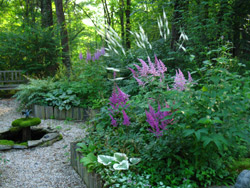Best Weed and Feed for Lawns in New York State
Green Yard and Garden Tips
Green Yard and Garden Tips

No pesticides are used to maintain this
garden of shrubs and perennials.
Herbicides, whether applied by themselves or in the form of weed and feed products that combine fertilizer and herbicide in one application, can easily run off into streams and lakes miles away and can migrate into groundwater supplies in areas of porous soils. Making small changes in how we care for our yards and manage outdoor pests can help protect water resources.
Reduce Pests in Your Yard Naturally
How to Reduce Weeds
Weeds move into lawns when conditions favor their growth over that of turf grasses.
- In late April, apply corn gluten to lawns. It will not kill weeds but will prevent new ones from germinating that year. It is also a natural source of nitrogen!
- Mulch, mulch, mulch! Add 2 -3 inches to add nutrients and shade out weeds in plant beds.
- Try bark chips, leaves, or recycled rubber mulch.
- However, do not allow mulch to touch tree trunks. Tree roots may grow in the mulched area which can eventually girdle and kill the tree.
- Pour boiling water over weeds; repeat to increase effectiveness.
Smart Plant Selections Can Reduce Pesticide Use
Head off pest and disease problems by choosing plants that have built-in disease and insect resistance. Choose climate-adapted and disease-resistant native species or non-invasive plants whenever possible.

Lawns are high maintenance and high cost.
A perennial garden is a better choice than
lawn for this shady area beneath the trees.
- Cool season grasses such as tall and fine fescues, kentucky bluegrass, and perennial rye grass are appropriate for the Northeast. Choose fescues for shadier areas. Pick grass seed mixes with more bluegrass for areas that are sunny and will receive more use.
- Toringo Crabapples are often recommended over native crabapples, which are susceptible to rust, scab, and fireblight.
- Roses are susceptible to black spot, but there are some resistant varieties. Try the hardy "landscape roses" which offer beautiful flowers, excellent cold-hardiness, and are disease resistant.
- White-barked birches are extremely popular, but plagued by the bronze birch borer. Choose the 'Heritage' river birch over the European white birch.
- Phlox, bee balm, and certain asters are susceptible to powdery mildew. Newer cultivars and hybrids such as Phlox 'David,' or 'David's Lavender,' New York Aster, and the beebalms 'Raspberry Wine,' 'Coral Reef,' and 'Marshall's Delight' are less prone to mildew.
- Lilacs are also mildew targets. Try 'Miss Kim,' the Meyer Lilac, little-leaf lilac, or the cultivar 'James McFarlane.'
Minimum Risk Pesticides and Biocontrols

Did you know that some insects are
beneficial? Bees are important pollinators.
Try minimum risk pesticides, which the U.S. Environmental Protection Agency states "pose little to no risk to human health or the environment."
Apply biocontrols (naturally occurring substances that control pests), such as parasitic nematodes, to your lawn to control grubs. Suppressing grubs will also help with mole problems.
Tips for Lawns/Turf
A healthy lawn will be able to endure drought, diseases, and pest infestations better than a stressed lawn. Healthy grasses can also compete better with undesirable weeds.

Cutting grass longer (2.5 inches or higher)
encourages longer, healthier roots.
- Leave grass clippings on the lawn
- Promote lawn health by mowing and watering properly:
- Taller grass develops deeper roots, an advantage during dry spells
- Lawns can go dormant during the hottest days of summer, but will green-up again easily
- Water deeply once a week only if needed; lawns need about an inch of water per week
- Water early in the morning to help prevent conditions that encourage pest infestations
- Follow local watering restrictions
- Over-seed bare spots in lawns with grass seed
Fertilizing Lawns
- Over-fertilization or applying fertilizer at the wrong time can harm your lawn; first determine IF there is a nutrient deficiency with a soil nutrient test
- Broadcasting up to a half inch of finished compost provides nitrogen, other trace nutrients, and organic matter to the soil
- More serious nitrogen deficiencies should be corrected with a slow-release, organic source of nitrogen such as blood meal, cottonseed meal, or fish meal
- Apply nutrients when soil temperatures are above 65 degrees
- Get 50% of your lawn's needed nitrogen by leaving clippings on the lawn; apply the other 50% in the fall by shredding leaves using a mulching lawn mower and leave them on the lawn
- If you fertilize an existing lawn in mid-summer, you're feeding the weeds!
Note: As required by NYS law, do not apply any fertilizer:
- containing nitrogen, potassium, or phosphorous between December 1 and April 1 or
- within 20 feet of any surface water unless there is a vegetative buffer of at least 10 feet, and
- do not broadcast fertilizer onto sidewalks and roads where it can run-off into storm drains or nearby waterways.
Healthy Plants Begin with Healthy Soils!

Test soil pH - turf grasses grow best
in soil that is neutral to slightly acidic.
Incorporate organic matter, such as grass clippings or composted leaves, into compacted soils to increase drainage and to sandy soils to increase water retention.
What Else Can I Do?
- Start a compost pile
- Collect water in a rain barrel for use in your yard
- Direct gutters to flow onto lawns rather than pavement
- Use IPM (Integrated Pest Management) for a combination of methods to prevent and reduce pests. IPM incorporates biological, cultural (e.g. clean up areas that attract pests), mechanical (e.g. exclusion fencing), organic, and chemical practices. For more information visit Cornell University's IPM webpage (See link at right).
Source: https://www.dec.ny.gov/public/52570.html
0 Response to "Best Weed and Feed for Lawns in New York State"
Post a Comment